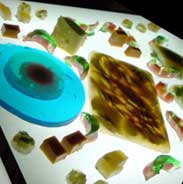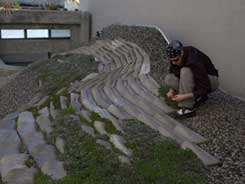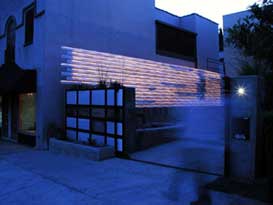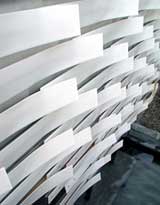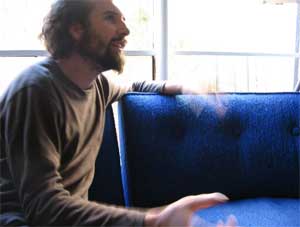 While i was in Los Angeles Beverly introduced me to Oliver Hess from Materials & Applications, a non-profit research center dedicated to pushing new and underused ideas for landscape and architecture into view. Twice yearly, they hold experimental installations in their courtyard. They also host open air lectures, performances, movie screenings and workshops. M&A accept unsolicited proposals from anyone wishing to experiment with materials and applications. Use of sustainable resources, renewable energy and smart technologies are encouraged to push the application of materials beyond what typical commercial and residential project limits allow towards a more liquid architecture.
While i was in Los Angeles Beverly introduced me to Oliver Hess from Materials & Applications, a non-profit research center dedicated to pushing new and underused ideas for landscape and architecture into view. Twice yearly, they hold experimental installations in their courtyard. They also host open air lectures, performances, movie screenings and workshops. M&A accept unsolicited proposals from anyone wishing to experiment with materials and applications. Use of sustainable resources, renewable energy and smart technologies are encouraged to push the application of materials beyond what typical commercial and residential project limits allow towards a more liquid architecture.
The group, lead by Jenna Didier and Oliver Hess, gained fame a few months ago when they inaugurated Maximilian’s Shell, aka the Golden Vortex. Designed by architects Benjamin Ball and Gaston Nogues, the installation warped M&A courtyard with a rendition of a celestial black hole.
Constructed in tinted Mylar resembling stained glass, the vortex functioned as a shade structure, swirling above the outdoor gallery through November 26th 2005. Images.
The name of the structure was inspired by actor Maximilian Schell‘s character Dr. Reinhard’ in 1979 Disney Studio’s sci-fi thriller, The Black Hole. Dr. Reinhardt was the nefarious captain of a robot army on a monomaniacal quest to harness the “power of the vortex” and possess “the great truth of the unknown!”
Other highlights include Land.Tiles, an articulated contoured topography consisting of 140 concrete cast and textured blocks manufactured through a process of CNC milling and vacuum formed plastic. Designed by Marcelo Spina , Land.Tiles was an “actively affective landscape micro environment” that includes a circuitry of continuous water flow that stimulates severe and shifting conditions. The project duration of six months allowed structural, surface, and vegetation conditions to be monitored over an extended period of time.
I wish i had been in LA in the Summer of 2004 to see Rob Ley‘s Serial Departure. The installation demonstrated that a simple and inexpensive material such as pine furring strips could be infused with a sophistication usually reserved for high-end materials.
By projecting digital information onto the fabrication bed, a system emerges in which curves developed through design in 3D modeling applications could be precisely replicated with a piece of wood. A variable jig composed of a pegboard and adjustable cams allows for the production of an almost unlimited number of unique curvatures, moving beyond the limitations of one mold equals one form. More interesting is that this same process allows for material feedback into the digital model. If at any point, the curvature exceeds the bending capacity of the wood, the computer model is adjusted to match the maximum profile the wood is able to bear. In this way, a feedback loop is created as information flows from the digital, to the real, and back into the digital.
How did Materials and Applications start?
Jenna was the one who had the idea and started the project in 2001. At the time, M&A space was just a concrete parking lot but Jenna tore out the whole front and installed a kind of fabric installation. I was an artist at the time and just happened to pass in front of the space with Marcos Luytens. He was one the first people to show his work here so he knew what Jenna was up to. I liked her idea of running an experimental space that follows meaningful pursuits. She explained me that she wanted to create a kind of environemental art space, a gallery that welcomes projects that blend architecture, art and design. I just thought it was one the best things i had ever seen.
It took a lot of time for people to understand what M&A is about but now we’ve got a lot of professors and their students who really grasp what’s going on here.
Did the huge coverage you got for Maximilian’s Shell changed the way people perceived your work?
Yes! Obviously, the Golden Vortex helped a lot. Since then we’ve received much more submissions. And many of them have a more traditional art approach (sculptures, etc.) We’ve never had that before, we used to be more architecture-oriented. But this opening up to more fine art projects is cool, we’ve received some really interesting proposals.
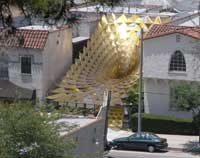
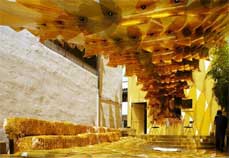 Maximilian’s Shell / The Golden Vortex
Maximilian’s Shell / The Golden Vortex
How do you explain the success of the Golden Vortex?
We worked a lot on every single detail. We spent a year discussing every element of it. Everything changed over time, it’s especially striking when you look at the pictures of the original prototype. What made the Golden Vortex special was the golden color of course, its massive structure and this hyperbox shape that defied anything you’d ever seen in the neighborhood. It just had an originality that people couldn’t resist. You couldn’t miss it: you could see people in their car slowing down to stare and point at it. It caused genuine wonderment.
It perfectly synthetises the experience we want to create with M&A. We believe that there isn’t any reason to go for “square things.” It’s not just a question of aesthetics, we’d like to see people thinking “out of the box.” We’re interested in systems to harvest rain water, how people insulate their home, etc. Ideas that wouldn’t make an installation but they are important to integrate in the dialogue.
M&A is also a social experience, right?
Yes, everything we organise has some social undertone. We always try to get as many people as possible involved so that they can also share the experience. M&A is non-profit and we’re helped by volunteers.
We have a “Cradle To Cradle” approach. We try to push a social agenda in a very mild way. M&A is about reforming the consideration of design, architecture and space. How the space is used, how it is appreciated. Anyone can participate to that.
How do you select the projects?
We don’t have a “board” yet but we have friends to whose opinions we appreciate. We try to avoid anything that is too patterned, too consistent or expected. We’re also looking for submissions that express certain cultural trends but played in a sort of environmental motif. We work on each projects for months (and in the case of the Golden Vortex, for over a year) with the artists: we have discussions, conversations, plannings, considerations. It’s a constant exchange and it involves a mass of investment of contemplation.
So obviously we try to work with someone with whom we can communicate regularly and with whom we really can get along.
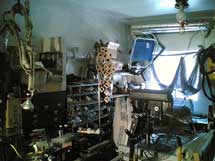
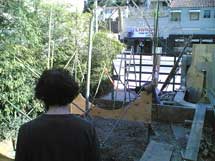 M&A workshop – Preparation for the upcoming installation
M&A workshop – Preparation for the upcoming installation
Once you have selected a project how much do you influence its evolution?
It depends on each projects. Some artists have very clear ideas, other would come with a more conceptual project and have no idea on how to execute it. Jenna has been a professional project manager for many years and i’ve been a professional technical director/producer of technical works. So she and I both work in those capacities on every project.
Are you sometimes tempted to select a big name for the installation? Someone whom you know with certainty that he or she will realize something successful?
No, such considerations do not apply at all here! All the works selected have a sort of borderline, irrational nature. They come with many difficulties, complexities and challenges. And it’s precisely the challenge that we’re interested into. Indicating to people the challenge, educating and inspiring the public is one of the most important elements of our pursuit. We want to prove that complex (neither Home Depot nor Mc Donald’s-like) environements can be enjoyed and appreciated by anybody. We hope to provide engaging experiences.
Would you consider opening similar places in other US cities or in other countries?
Yes, we’d like to expand the formula. We would love to see more people adopt the concept in other places. We consider doing our projects in various spaces across the city.
Thanks Oliver!
Unfortunately when i visited M&A, the Golden Vortex was already down and the group was working on the new show which opens on March 15. Called Here There Be Monsters, it will involve flooding the entire space with water and creating a responsive environment.
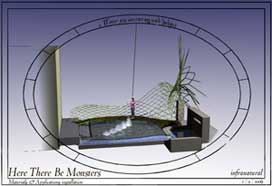
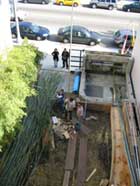
The installation, by infranatural, Bruce Danziger of Arup and Sci-Arc and architects Moritz Freund and Shu-Chi Hsu, will explore the challenges of synchronizing the aesthetics and intrinsic characteristics of natural materials in the built environment with the latest computer aided design tools and embedded control system technologies.
Experience of the space will vary depending on the visitor: children playing with energetic motions will create turbulent water spouts that react to their movements, calmer visitors may discover a more cerebral response within the patterns formed by mist emanating from intersecting wave patterns created by walking over the bridge.
The systems are self-learning so the installation will grow within its computational environment while the live bamboo woven into the bridge continues to grow too. The entire environment will evolve over the course of its exhibition tim.
Opening Reception for Here There Be Monsters: 2 – 6pm, April 1st, 2006. Materials & Applications, 1619 Silver Lake Boulevard in Los Angeles.
Portrait of Oliver by Jason (who also made this slideshow, thanks J.)
Mine on flickr.

